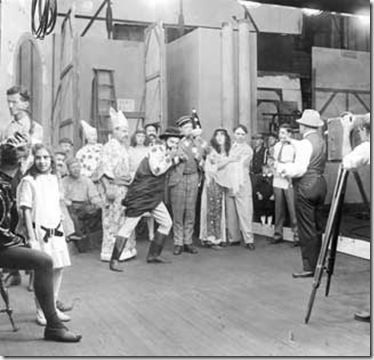Tonight, TCM presents the first of seven one-hour episodes of its ambitious history of filmmaking in America, Moguls & Movie Stars: A History of Hollywood [Mondays, 8/7C]. Featuring previously unseen footage [a Frenchwoman directing a sound-sync film twenty-two years before The Jazz Singer!] and interviews with both noted film historians and Hollywood luminaries, the series looks at American filmmaking over the seven major periods ending in 1969. It begins with Peepshow Pioneers, which delves into the predecessors of film [there was a two hundred and fifty year history of entertainment projected on a screen prior to the invention of motion pictures] and introduces some of film’s most important innovators.
Peepshow Pioneers (1889-1907) opens with a five-minute overview of the seven periods of filmmaking that the series will cover before looking at the history of ‘magic lanterns,’ Peepshow Pioneers’ and showing how the work of technical innovators like Thomas Edison and Brothers Auguste and Louis Lumiere [and others] pushed the technology and began to develop the idea of actual storytelling in film. It then introduces the brothers Warner, Louis B. Mayer, Carl Lemmle, William Fox and D.W. Griffith [among others] and notes that many of film’s early moguls were immigrants from Eastern Europe who came from areas within four hundred and fifty miles of each other.
There’s a brief look at film’s first real star, Canadian Mary Pickford and her successor as the period’s first ingénue, Lillian Fish before it moves on to a more detailed look at the early Griffith. The episode ends with filmmakers fighting a monopoly spearheaded by Edison, who was fiercely protective of his technology, and heading west – leading into next week’s The Birth of Hollywood.
Besides well known film historians like Leonard Maltin, Peepshow Pioneers features interviews with such unexpected people as Carl Lemmle’s niece and actor/film historian/slight-of-hand artist Ricky Jay. The result is a real feel of connection to both the period and its accomplishments.
Photos and film from the period are combined with informative – but not dull – narration by Christopher Plummer and the aforementioned interviews, but some of its most impressive parts are glimpses into things most of us have never seen before. Two of these are photos of Edison’s first movie studio [referred to as the Black Mariah because its black, tarpapered exterior reminded of police paddy wagons] and the clip of a sound-sync film being directed by Alice Guy Blanche in 1905.
Christopher Plummer is a good choice as narrator because he is tremendously talented and well respected – and rarely appears in material of lesser quality. His presence adds credibility to the proceedings which could have been self-congratulatory [there are a few moments] but are, instead, mostly remarkably objective.
Of course, informative or not, what really matters to the average moviegoer isn’t necessarily whether a documentary is informative but rather, whether it’s entertaining. Writer/producer Jon Wilkman has clearly seen fit to counterpoint drier historical material with cool visual material so that there’s never a moment when the audience will feel the need to change the channel. Because of Wilkman’s astuteness, Moguls and Movie Stars has a low-key charm that is very engaging.
TCM’s most ambitious production is a success.
Final Grade: A
The remaining six episodes are: The Birth of Hollywood (1907-1920); The Dream Merchants (1920-1928); Brother, Can You Spare a Dream? (1929-1941); Warriors and Peacemakers (1941-1950); The Attack of the Small Screens (1950-1960) and Fade In, Fade Out (1960-1969).
